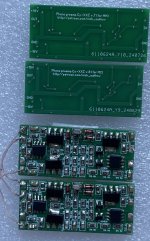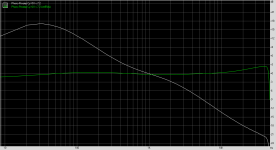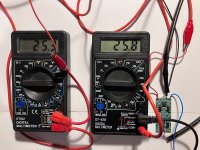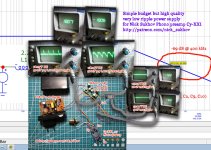I don't understand your question. The output should be 0 DC voltage. And what does the speaker have to do with it?!the same voltage hangs at the output
It's easy to check. We can connect with video and I will be able to measure preamp output DC for you. Or you can see it in the Microcap yourselfI will clearly look for the truth
Artmaster
When supplying power from the power supply unit to the phonocorrector, plus minus 15 volts. And if you pick up, say, a speaker at the output, then this voltage disappears. Is it normal?
My circuit has fine DC servo with eTrim opamp OPA192 and guarantees < 5uV DC (not mV but uV ! ) output offset (no need electolytics caps at input, inside or output) both with idle output and with any load up to short circuit. Instead of 500 uV offset of 5532 Pearl 3 output. See here
Attachments
 Konard, the schematic has been reported as copyrighted material. This is the third time we need to remove it.
Konard, the schematic has been reported as copyrighted material. This is the third time we need to remove it.Please play by the rules:
Posts containing material covered by copyright, which are subject to Non-Disclosure Agreement or is otherwise subject to obligations of confidentiality owed to third parties without permission of the respective copyright owner or controller of the confidential information. Requesting such information is also not allowed.
Last edited:
How is your scheme fundamentally different from this ancient Kenwood ka-9100-9150 ?people ask a few times Please check
Actually it is commercial and contains plain lies in english and russian content that we don't understand. You even misspelled the author's name which can't be Nick...One of the policies of this forum is the use of english..And nothing's perfect...vinyl included.
INTERESTING
I don't see such elements as JFE2140 and OPA192 in Kenwood. I also see many electrolytic capacitors in Kenwood.How is your scheme fundamentally different from this ancient Kenwood ka-9100-9150 ?
All circuits have similarities. Because they consist of common elements. These elements are called resistors, transistors, capacitors. It's like music. It also consists of sounds and notes. Only in one case we get a symphony, and in the other case, cacophony.
Last edited:
All circuits have similarities
We cancel all patents - since the presence of transistors is a sign of the same circuit - because “Because they consist of common elements”!
But seriously - the question was about “fundamental” differences, and not about different markings of parts
as for OPA192 - this is the use of Kenwood circuitry (Kenwood - Sigma-Drive Technical Guide) -
https://www.diyaudio.com/community/threads/kenwood-sigma-drive.135517/
https://ru.scribd.com/document/411868140/Kenwood-Sigma-Drive-Technical-Guide
Changing the resistor or capacitor value leads to fundamental changes in the transistor's operation. Even a schoolboy knows this. In one case, the transistor works as an amplifier, in the other, it is excited and works as a generator.But seriously - the question was about “fundamental” differences, and not about different markings of parts
I think it's time for you to calm down. And engage in constructive creativity. Come up with your own scheme and get to work. No need to hype and parasitize on other people's developments.
I think it's time for you to calm down.
when there is no question, there is always an answer
the opposite is also true!
I asked understanding people "How is your scheme fundamentally different from this ancient Kenwood ka-9100-9150?"
I am convinced that the answer to this question is of interest to many forum participants
but other than “you are sick patients of Dunning Kruger” - there were essentially no more answers.
This is for uninvolved users. For the rest, it is enough to look at the diagram, the package and, most importantly, the parameters. Do you have any questions about them? Subject to the measurement conditions, of course. With a shorted input or chaos at the input, they will be radically different.but other than “you are sick patients of Dunning Kruger” - there were essentially no more answers.
I have a new version of the factory-made board, with gold-plated contacts at a cheaper price, including a power supply of your choice - either with a step-down transformer and stabilizer, or a DC-DC converter, operating from any unipolar voltage source from 4 to 30 Volts.Another version of a possible mini board.
You write offensive things. We discuss conceptual solutions and their results here. I am ready to sell my author's crookedly soldered sample for twice the price of a factory copy. Do you mind?Finally, something that doesn't look like frankensteins monster solder it
- Home
- Vendor's Bazaar
- Nick Sukhov SU-XXI MM Phono stage -85 dBA SN ratio...





